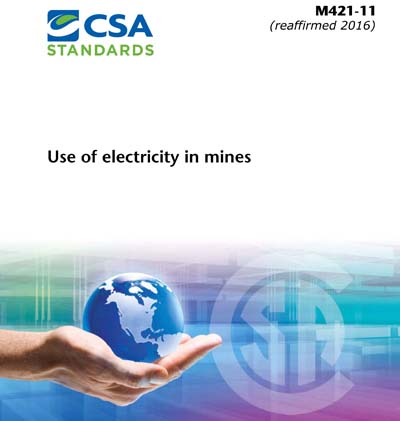Historical
CSA M421-2011 (R2016)
M421-11 (R2016) - Use of electricity in mines
Preface
This is the fourth edition of CSA M421, Use of electricity in mines. It supersedes the previous editions, published in 2000, 1993, and 1985.Scope
1.1 PurposeThis Standard establishes minimum requirements for electrical work and electrical equipment operating, or intended to operate, in mines. Note: Users should be aware that federal, provincial, and territorial legislation can impose additional requirements.
1.2 Application
This Standard is intended to be used with the requirements of the Canadian Electrical Code, Part or local regulatory amendment thereto, unless such requirements are modified by this Standard. Note: Adherence to the Canadian Electrical Code, Part I, normally addresses the minimum electrical safety requirements for mining-related fixed buildings, structures, and premises located on the surface, as these are no different from other industrial facilities. Such facilities could include processing plants, camps, offices, and drys. However, specific applications can exist within or on such buildings, structures, or premises that warrant the application of this Standard, e.g., the following equipment operating at voltages exceeding 150 V to ground: (a) mobile equipment fed by portable power cables; (b) movable equipment fed by portable power cables where the ground-fault voltage and ground potential rise relative to the surrounding earth or structures cannot be limited to 100 V; and (c) quick-connect couplers that are not mechanically interlocked with a load-break-rated disconnect switch.
1.3 Application to non-mining structures
This Standard does not apply to tunnels, aqueducts, conduits, or excavations for civil construction purposes. However, where mines incorporate such structures, this Standard applies.
1.4 Clause numbering system
This Standard is divided into seven clauses, numbered from 1 to 7. Clauses are further divided into subclauses (e.g., Clause 4.3). There can be up to five levels of subclauses (e.g., Clause 4.3.3.3.1). Multiple items, designated by lowercase letters in parentheses (e.g., (a), (b), (c)) can be enumerated in a list. If an item requires further listing, subsidiary items are identified by lowercase Roman numerals in parentheses (e.g., (i), (ii), (iii)). Items in a further list under these subsidiary items are identified by an Arabic numeral in parentheses (e.g., (1), (2), (3)). Note: For further information see CSA-SDP-3.2.
1.5 Inclusive lists and selective lists
The use of the conjunction and between two or more items in a sentence or list conveys an inclusive relationship, i.e., all of the items or conditions in the list are included in the criteria (i.e., all items present or conditions satisfied). The use of the conjunction or between two or more items in a sentence or list conveys a selective relationship, i.e., at least one of the items or conditions in the list is included in the criteria (i.e., a selective choice).
1.6 Terminology
In CSA Standards, shall is used to express a requirement, i.e., a provision that the user is obliged to satisfy in order to comply with the standard; should is used to express a recommendation or that which is advised but not required; and may is used to express an option or that which is permissible within the limits of the standard. Notes accompanying clauses do not include requirements or alternative requirements; the purpose of a note accompanying a clause is to separate from the text explanatory or informative material. Notes to tables and figures are considered part of the table or figure and may be written as requirements. Annexes are designated normative (mandatory) or informative (nonmandatory) to define their application.
CSA America, Inc. [csa]

